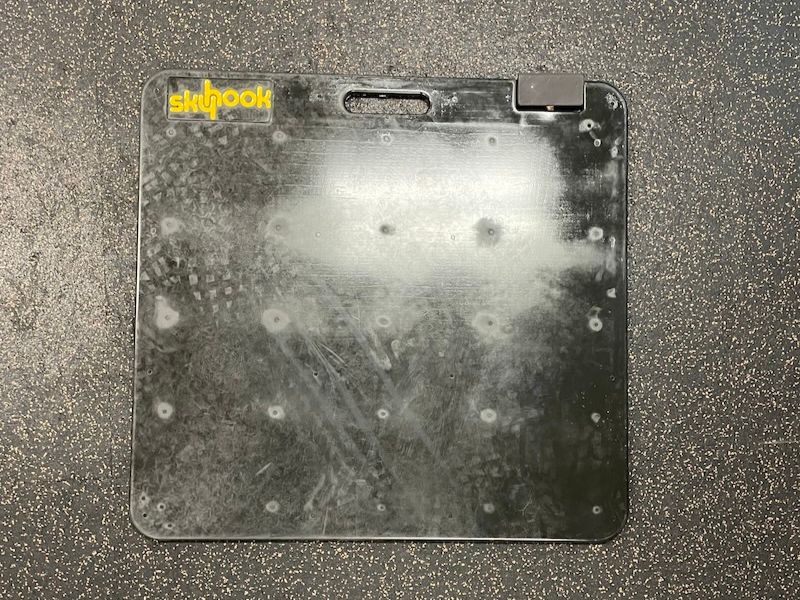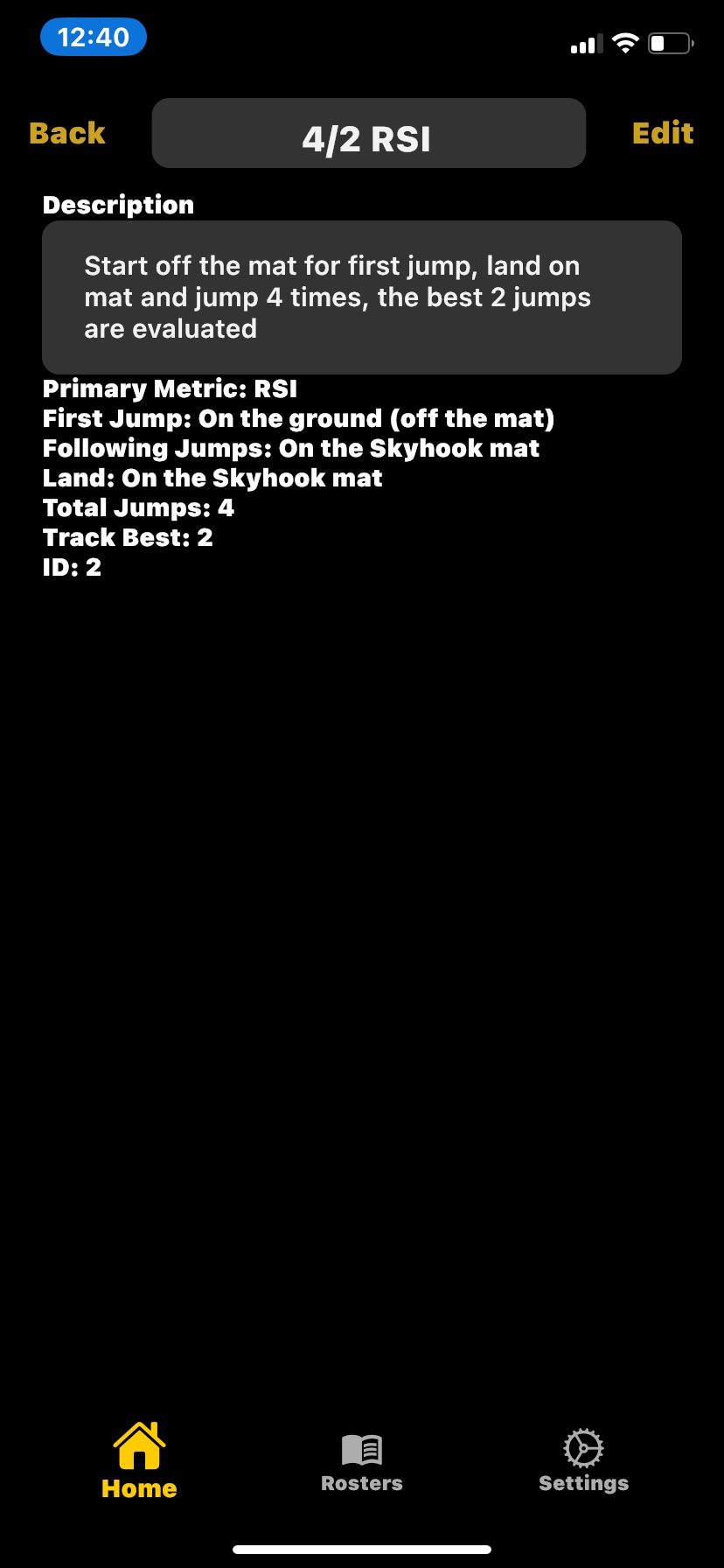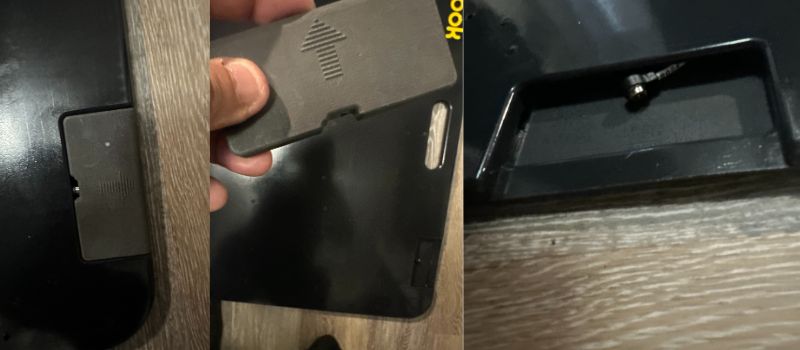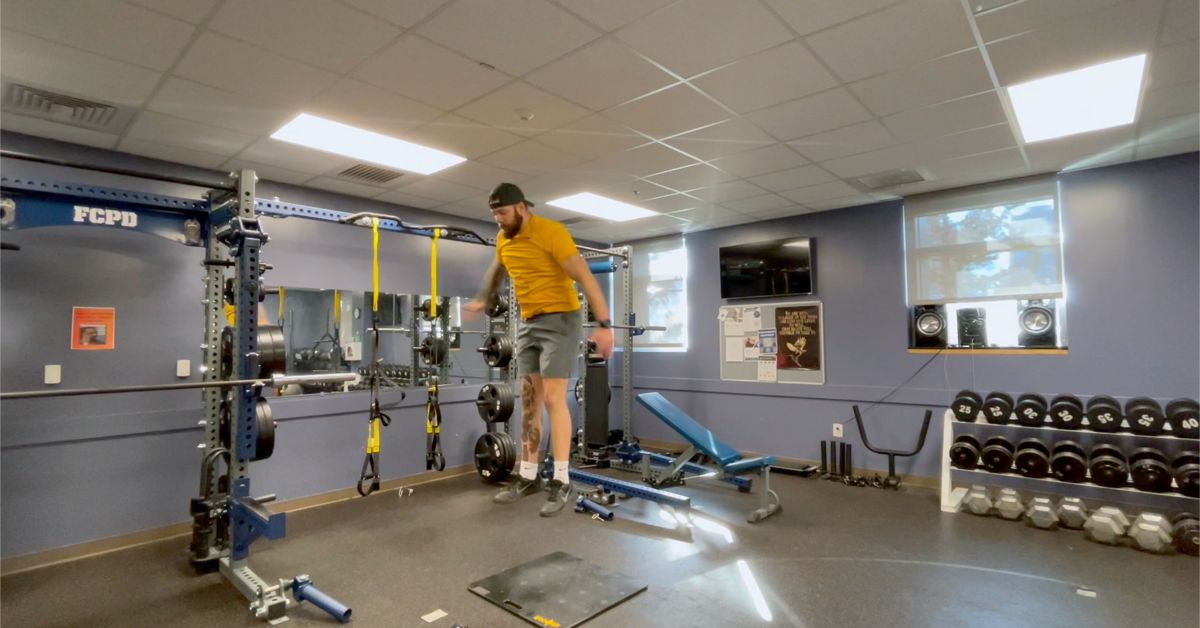The Skyhook contact mat is a wireless jump mat that can be used to assess an assortment of jumps. The mat connects to a free training application that captures and tracks data over time, allowing you to upload your team rosters and track your jumps through indicators such as jump height, airtime, and ground contact time. It can also calculate an individual’s reactive strength index (RSI). There is really no limit on the assessments that can be performed since it allows you to create your own jumping assessments in a custom protocols option.
The objective of this review is to give my personal experience with the product, explain what it is and how it works, and examine three major factors when comparing it to similar products:
- Functionality
- Durability
- Pricing
This product has vastly improved our testing efficiency and saved us precious amounts of time in doing so. This article is meant to help other coaches better decide if the Skyhook contact mat is right for them and whether it could similarly benefit those they work with.
What Is the Skyhook Contact Mat?
The Skyhook mat resembles a battle shield, with a jumping surface area of 31 inches by 31 inches and a weight of almost 30 pounds. Its solidity stood out to me immediately when I first received the mat. I’m told the mat is made from a secret, proprietary polyurethane blend, and I have no doubt that this mat will last, seeing as how I’ve tried to break it multiple times with no success. The package also includes the charger and battery to power the mat, along with a digital setup guide.
I’m told the Skyhook contact mat is made from a proprietary polyurethane blend, and I have no doubt this mat will last, seeing as I’ve tried to break it multiple times with no success. Share on XWhile not a tangible piece of equipment, the training application that comes with the mat takes the product up a level. The ability to connect to the mat via Bluetooth and use it to evaluate an array of assessments online or offline is a powerful capability. The data gets saved into a cloud-based storage system that you can access to show trends in training, improvements, averages, and more.

Video 1: Skyhook app walkthrough.
How to Set Up the Skyhook Contact Mat
When setting up the Skyhook mat, the first thing you’ll need to do is download the Skyhook application on your phone or tablet. The app is compatible with both iPhone and Android and comes with the purchase of the mat. There isn’t a subscription fee, which was nice to see and rare with a cloud-based training software.
Once the app is downloaded, it will walk you through creating a profile via email to log in, and you can then begin utilizing the mat to its full capabilities. This entire process will take you a few minutes at most.
When logged in, you first need to start using the mat to connect to Bluetooth via your phone or tablet. The mat does disconnect and go into sleep mode if there is a long break during its use.
The sleep mode helps preserve battery life (and it took an entire week of use until I needed to charge my mat for the first time). The charging guidelines from Skyhook state that the battery will last 2–4 hours with consistent use over multiple hours and can last up to 7–10 hours for less consistent use over 1–2 days. I can vouch for this with my sporadic use matching the latter pattern.
The battery takes 12 hours to charge fully—while that is quite a long time, I recommend just charging it after each use, and you should never have a dead battery on your hands.
Skyhook Mat Training Use
When beginning to go through the app, it can initially seem like a lot—I recommend just playing around with the app and discovering options for yourself. The app even has a setting called “Playground,” which is essentially a demo-mode option for this exact purpose and does not save any of the collected info.
The Skyhook’s app has a customization option that walks you through creating your own jump assessments specific to your athletes. Share on XThe Skyhook contact mat can be used to test several preprogrammed jump assessments, and it also has a customization option where it will walk you through creating your own jump assessments specific to your athletes.
Video 2. How to create custom jump protocols in the Skyhook app.
The app does briefly explain the assessments to the user, giving a short description of how to perform the test and what it’s testing. I think this could be improved by including more information, such as why you would want to perform the assessment and, if possible, even a brief video of the assessment.
To some extent, having so many options can be a bad thing since it floods coaches with information and assessments that may not be relevant to their situation. Giving the why and videos could potentially make it clearer to the user what jump assessments would be most appropriate for their athletes and situation.

How the Skyhook Mat Has Worked for Me
The Skyhook mat has saved me considerable time when performing vertical jump assessments and collecting the data. I primarily work on the tactical side of strength and conditioning, occasionally working within athletics on a small scale. I was initially concerned that the Skyhook mat would be overkill for my situation—like trying to kill a fly with a shotgun—since I do not and cannot perform many of the jump assessments with the police officers I work with.
I have still found significant value in the product, and it makes the jumping assessments that we use with our police recruits easier to execute. Much of my job isn’t at a set location, so I feel comfortable moving the mat and using it with a variety of locations and surfaces, and even outside!
We had performed most of our previous vertical jump testing with a Just Jump mat, so there was an initial concern about the change in data since the Skyhook mat does not function off the Just Jump formula. This would render our previous information worthless if the Skyhook mat were used in the future; it wasn’t a major issue but a large inconvenience. Skyhook, however, created a Just Jump Adjustment that you can enable in the settings to make your data points comparable to those tested in the past with a Just Jump mat.
Skyhook created a Just Jump Adjustment that you can enable in the settings to make your data points comparable to those tested in the past with a Just Jump mat. Share on XSomething that I haven’t done yet with the Skyhook mat, but that I’ve done in the past with other products and plan to do moving forward, is use the vertical jump as an assessment for readiness. (I discuss this in a prior article, “Four Low-Cost Athlete Readiness Tools to Enhance Your Program.”) Having the app show trends throughout the jump and being able to identify specific points—such as the average, median, max, and minimum of various jumps and metrics—would make it easier to quickly gauge the vertical jump as a readiness assessment within any size group.
How It Compares
When comparing the Skyhook mat to other products that assess jumping, there are two that immediately come to mind: the Just Jump mat and stick-based alternatives, such as the Jump USA Vertec (and clearly, the Just Jump mat is what coaches will find most comparable to Skyhook).
I considered three major factors when comparing these products: functionality, durability, and price.
1. Functionality
I find the Skyhook mat to be superior in functionality for a few reasons, the first being that it can perform multiple jump assessments and includes the ability to create your own assessments with little to no limitations.
I understand that the other options allow you to perform more than just a standard vertical jump, but the Vertec and similar stick options only give you the height jumped. They don’t include things such as hang time, ground contact time, and RSI.
The Skyhook training app enables you to track and save all your athlete’s information, which enhances the user’s experience and can aid in the training process by offering information to make better programming decisions. Neither comparable product can do this.
2. Durability
The durability of the Skyhook mat is something that I find to be of extreme value. I’ve used comparable products in every other location I’ve worked, and those haven’t always stood the test of time when put through the wringer.
I’ve used comparable products (to the Skyhook contact mat) in every other location I’ve worked, and those haven’t always stood the test of time when put through the wringer. Share on XWhether it be the cords of the mats getting stepped on and torn by high school students or sticks breaking off from college athletes swatting too hard, the durability of these pieces has created headaches over extended periods. I prefer to purchase training equipment one time only, then use and abuse it for its lifetime.
My primary concern with the Skyhook mat was its charging cord, which connects the battery. This is its weak point and the only thing likely to break or wear on the product. It also isn’t very easy to fit the battery into the mat unless you get the wire to push it in just right.
Diving deeper into the product, though, I discovered that Skyhook recently corrected this on their newest generation model. (I have an older model.) The newly upgraded model removed the wire and is now connected through a magnet on the port and battery instead.

This is important, not only because SkyHook corrected a potential weak spot on the product but also because it shows the company continues to improve upon its product, something that we should be able to expect from all companies.
3. Price
With all of that said, the price point on the Skyhook mat matches its quality. The Skyhook contact mat costs $1,389. This is higher than comparable products, with the Just Jump mat priced between $790 and $893 and the Vertec at $925. (And other similar companies sell their stick vertical jump testers for even less.) These prices don’t include shipping, taxes, etc.
While the price for Skyhook is higher, I find the product to be worth the extra cost if you plan to utilize jump assessments on even a semi-routine basis. This is due to the previously discussed increased functionality and durability.
Ultimately, coaches will have to make this decision based on what is best for them and their situation.
Exercises, Setting, and Demos
Free Jump
The Free Jump setting is not necessarily meant to be the Vertical Jump setting, although I’m sure many, like me, will use it as such. Instead, the Free Jump is described as “jumping with no limits”—basically, you can do whatever on the mat, and it will measure the jump height.
You can go into the jump settings and edit this function, which will help prevent common double jump mishaps, and even change its name, or you can create your own vertical jump testing assessment.
Video 3. Vertical jump on Skyhook.
Single Depth Jump – Height
This assessment starts with the athlete off the Skyhook mat—they will essentially perform a hop, drop onto the mat and use it as a springboard to jump as high as possible, and then land back on the mat. This is a more advanced test for lower-body power and jumping ability since the individual lands and rebounds into the jump.
The assessment measures height from the single jump, and this can be made more specific by using the custom creator and performing it off specific box heights.
Video 4. Single-depth jump for height.
Video 5. Single-depth jump from a 6-inch box.
4/2 RSI
The RSI assessment with the Skyhook mat begins with the individual off the mat. From there, they will jump onto the mat and perform four jumps. While it will measure all four jumps, only the best two will be evaluated.
Finding an athlete’s RSI is beneficial because it demonstrates how well someone can utilize the stretch-shortening cycle, moving from an eccentric to concentric muscle contraction—essentially what we see in the world of sport or when high operators need to execute their jobs at high outputs.
Video 6. Completing four jumps for the RSI test on Skyhook.
10-Second Ground Time
The 10-second ground time jump assessment examines the total ground contact time during the period. The ability to produce force quickly and minimize contact time is a crucial trait for many in athletics, and this assessment is great for teaching athletes to be freer, more fluid, and more reactive when it comes to jumping.
Video 7. Using duration to assess ground contact time.
Five-Jump Air Time
The five-jump assessment is the only preprogrammed assessment measuring air time. For this assessment, you will do exactly as it sounds, performing five continuous back-to-back jumps on the mat, and it will calculate your time spent in the air.
This test could be utilized with individuals who need to maintain their power for a particular amount of time, even if it doesn’t line up perfectly; a basketball player would probably not get five back-to-back chances in the same series to get a rebound, but it still helps broaden their abilities and provides a fun challenge.
Video 8. A five-jump test measuring time in the air.
Single Hurdle Jump
Another jump to assess ground contact time is the single hurdle jump. Starting off the mat, with a hurdle between you and the mat, you will perform a hop over the hurdle. Upon landing, you want to explode back up like you touched hot lava and land off the mat.
I chose to use a smaller hurdle of 6 inches, but this could be modified for more advanced individuals at larger heights: 8 inches, 10 inches, 12 inches, etc.
Video 9. Single hurdle jump test to assess GCT.
Custom Options
Weighted Jumps
One of the first custom jump options I created was a weighted vertical jump. I found value in this because most of the individuals we work with can make the connection of performing tasks with weight greater than their body weight, and it is still a valid test to demonstrate the ability to produce force.
When utilizing this protocol, I chose to use 10% of the individual’s body weight; for example, a 200-pound individual would hold a pair of 10-pound dumbbells for 20 pounds total.
Video 10. Using Skyhook’s custom jump protocols, a weighted jump performed with two dumbbells.
Paused Jumps
One could dive deep down the rabbit hole of vertical jump variations. Things such as where you place your hands, the angled position of the hips, and other small details can all affect the athlete’s vertical jump and be of value to a coach in certain circumstances.
I like having a paused training option when working with athletes because it can give some information on whether an athlete is more force- or velocity-dominant. Share on XI like having a paused training option when working with athletes because it can give some information on whether an athlete is more force- or velocity-dominant. I know there are other ways to find this, and the coach’s eye can give you a great idea, but this is another option that will not cost you a lot of time.
Have athletes hold the bottom position of the jump for a three-count before taking off—just be mindful of them dropping down too quickly and the mat attributing that as the jump. You can edit the jump recorded through the custom options to prevent this.
Video 11. Holding the bottom position in a pause jump.
Single-Leg Vertical Jump
While not as common, performing single-leg vertical jumps can be great in sports where jumping is a main facet, such as basketball, volleyball, and track. It is also helpful to show any large imbalances between limbs that could provide some value and just get your athletes more comfortable performing max effort jumps from a single leg.
I’ve personally used the single-leg vertical jump tests in the past with track athletes and programs. It can create a lot of clutter when tracking, something the Skyhook would have helped with all those years ago.
Video 12. Single-leg vertical jump to two-footed landing.
Be Creative, Have Fun
The strength of the Skyhook mat is that the custom options are only limited by the coach’s ability and creativity. I think this is crucial for a product designed to measure jump performance because jumps really have no limitations.
The Skyhook mat’s custom options are only limited by the coach’s ability and creativity. This is crucial for a product designed to measure jump performance because jumps really have no limitations. Share on XUse assessments in warm-ups to perform multidirectional jumps, use the mat to perform jumps in the lateral plane, and/or have jumping competitions of all different metrics—be creative and have fun.
Video 13. A wide range of jumps can be performed on the Skyhook and tracked in the custom protocols.
Final Take
Overall, the Skyhook contact mat is a fantastic product that can help improve a coach’s ability to assess jumping metrics and collect that information in an organized fashion. The addition of the training application greatly improves its functionality, and the brute durability of the product helps me justify its value regardless of its higher price point.
Coaches should assess where their values lie with using training tech, but I have no doubts that this product offers a significant amount of value.
Since you’re here…
…we have a small favor to ask. More people are reading SimpliFaster than ever, and each week we bring you compelling content from coaches, sport scientists, and physiotherapists who are devoted to building better athletes. Please take a moment to share the articles on social media, engage the authors with questions and comments below, and link to articles when appropriate if you have a blog or participate on forums of related topics. — SF





